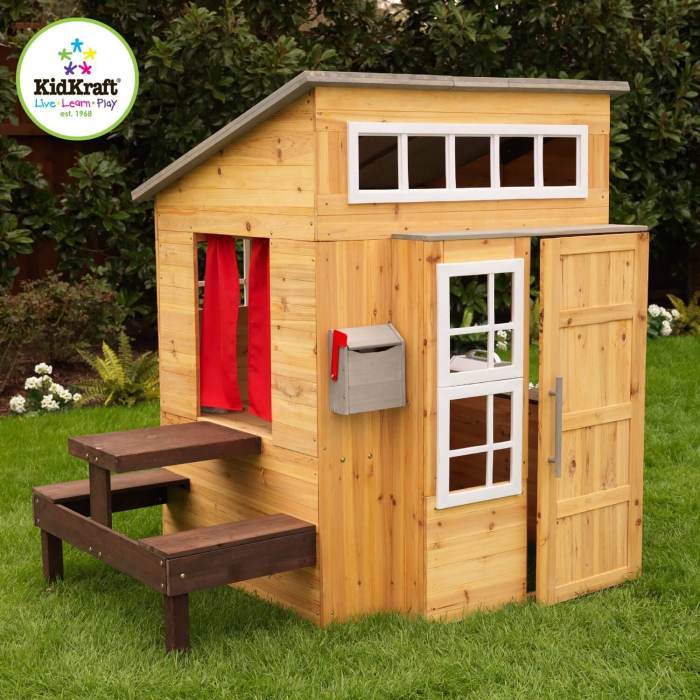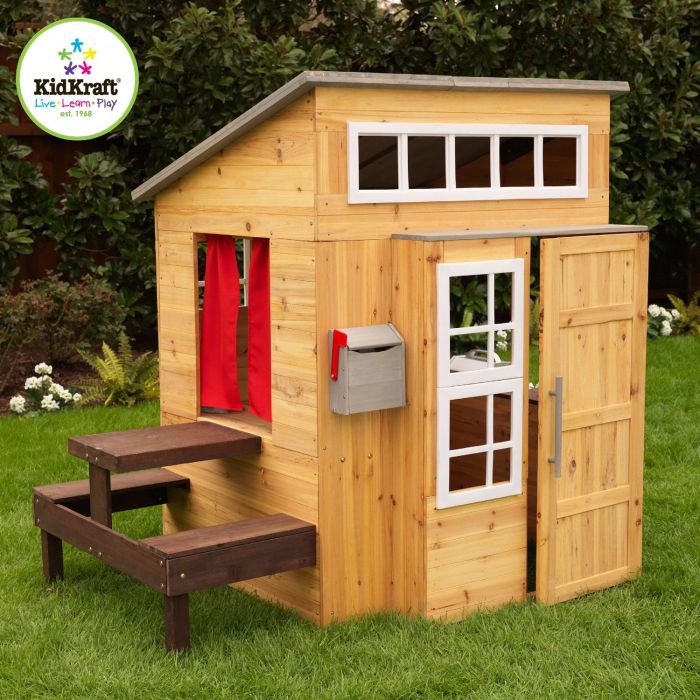DIY outdoor playhouses are becoming increasingly popular as parents seek to provide their children with imaginative and engaging play spaces. Building a playhouse offers a multitude of benefits, fostering creativity, imagination, and a love for outdoor play. It’s a rewarding project that allows you to create a unique and personalized space where children can let their imaginations run wild.
This comprehensive guide will walk you through every step of the process, from planning and design to construction and personalization. We’ll explore different materials, tools, and techniques, ensuring you have the knowledge and confidence to create a safe and enjoyable playhouse for your little ones.
The Appeal of DIY Outdoor Playhouses

In today’s digital age, where children are increasingly drawn to screens, the allure of a DIY outdoor playhouse is resurfacing. This trend is fueled by a growing desire to encourage imaginative play, foster a love for the outdoors, and create lasting memories. Building a playhouse is more than just a construction project; it’s an opportunity to ignite creativity, inspire exploration, and cultivate a deeper connection with nature.
Benefits of Building a Playhouse
Building a playhouse for your children offers numerous benefits that extend beyond the joy of creating something together. It fosters a sense of accomplishment, strengthens family bonds, and provides a dedicated space for imaginative play.
- Creativity and Imagination: A playhouse becomes a canvas for children’s imaginations. It transforms into a castle, a spaceship, a pirate ship, or any other fantastical world they envision. This imaginative play is crucial for cognitive development, problem-solving skills, and emotional intelligence.
- Outdoor Play: A playhouse encourages children to spend more time outdoors, enjoying fresh air, sunshine, and the wonders of nature. This exposure to the natural world promotes physical activity, reduces stress, and fosters a connection to the environment.
- Family Bonding: The process of building a playhouse together creates shared experiences and memories. It fosters communication, teamwork, and a sense of accomplishment. The playhouse itself becomes a symbol of family unity and love.
Essential Tools and Equipment: Diy Outdoor Playhouse

Building a DIY playhouse requires a range of tools and equipment to ensure a safe, sturdy, and aesthetically pleasing structure. These tools can be categorized based on their function in the construction process.
Measuring Tools
Accurate measurements are crucial for ensuring the playhouse fits its intended space and that all components are sized correctly.
- Measuring Tape: A retractable tape measure is essential for taking precise measurements of the playhouse’s dimensions, including the walls, roof, and windows.
- Level: A level ensures that the playhouse’s foundation, walls, and roof are straight and horizontal. This prevents unevenness and ensures stability.
- Carpenter’s Pencil: A pencil is used to mark measurements on the wood and to transfer design elements onto the construction materials.
Cutting Tools
Cutting tools are essential for shaping and sizing the wood used in the playhouse construction.
- Circular Saw: A circular saw is used for making precise, straight cuts in plywood, lumber, and other materials. It’s essential for cutting the walls, roof panels, and other components to size.
- Jigsaw: A jigsaw is used for cutting curves and intricate shapes, such as window openings, decorative elements, and roof overhangs.
- Hand Saw: A hand saw is a versatile tool for making straight cuts in wood, especially for smaller pieces and trimming edges.
Fastening Tools
Fastening tools secure the various components of the playhouse together, ensuring its structural integrity.
- Hammer: A hammer is used to drive nails into wood, securing the frame and attaching various components.
- Screwdriver: A screwdriver is essential for driving screws, which provide a more secure and durable connection than nails.
- Drill: A drill is used for pre-drilling holes before driving screws, preventing wood from splitting. It can also be used for driving screws into metal components.
- Power Drill: A power drill can make the process of drilling holes and driving screws significantly faster and easier, especially when working with thicker wood or multiple fasteners.
Finishing Tools
Finishing tools are used to enhance the appearance and durability of the playhouse.
- Sandpaper: Sandpaper is used to smooth out rough edges and surfaces, preparing the wood for painting or staining.
- Paintbrush: A paintbrush is used to apply paint or stain to the playhouse, providing a protective layer and adding color and style.
- Roller: A roller is used to apply paint or stain to larger surfaces, making the process quicker and more efficient.
Safety and Security Considerations
Building a DIY playhouse for your children is a wonderful way to create a fun and imaginative space for them to play. However, it’s crucial to prioritize safety and security to ensure their well-being while they enjoy their new playhouse.
The safety of your children is paramount, and it’s essential to be aware of potential hazards and take steps to mitigate them. This includes choosing sturdy materials, employing secure construction techniques, and incorporating appropriate safety features.
Preventing Falls and Injuries, Diy outdoor playhouse
It’s essential to ensure the playhouse is stable and secure to prevent falls and injuries.
- Use sturdy materials such as pressure-treated lumber, which is resistant to rot and decay.
- Securely fasten all components, including the roof, walls, and floor, using appropriate fasteners and construction techniques.
- Install handrails or guardrails on elevated platforms or stairs to prevent falls. These should be securely attached and have a height appropriate for young children.
- Ensure that the playhouse is placed on a level surface, free from obstacles or tripping hazards.
Ensuring Proper Ventilation
Adequate ventilation is crucial to prevent the buildup of moisture and mold inside the playhouse.
- Install windows or vents to allow for air circulation.
- Consider using a roof overhang to protect the playhouse from direct rain and sunlight.
- Ensure that the playhouse is positioned in a well-ventilated area to prevent stagnant air.
Protecting Against Weather Conditions
Protecting the playhouse from harsh weather conditions is essential for its longevity and safety.
- Use weather-resistant materials, such as treated lumber, metal roofing, or waterproof paint, to ensure the playhouse can withstand rain, snow, and sun.
- Consider adding a roof overhang or a weatherproof cover to protect the playhouse from direct rain and sunlight. This will help to prevent water damage and keep the playhouse cool during hot weather.
- Regularly inspect the playhouse for signs of wear and tear and make repairs as needed. This will help to prevent further damage and ensure the playhouse remains safe and secure.
Tips for Success and Troubleshooting

Building a DIY playhouse can be a rewarding experience, but it’s not without its challenges. By being prepared and learning from common mistakes, you can ensure a successful project and create a lasting play space for your kids.
Common Challenges and Solutions
Many DIYers encounter common issues during playhouse construction. Here are some tips to help you overcome these challenges:
- Material Selection: Choosing the right materials is crucial for both aesthetics and durability. Consider the playhouse’s size, intended use, and your budget. For example, if you’re building a large playhouse, using pressure-treated lumber for the foundation will ensure long-lasting resistance to moisture and rot.
- Construction Techniques: Using proper construction techniques is essential for a sturdy and safe playhouse. For instance, always use screws instead of nails for added strength and durability.
- Design Decisions: Design choices, such as roof pitch and window placement, can impact the playhouse’s functionality and appeal. Consider factors like ventilation, natural light, and ease of access when making these decisions. For example, a steeper roof pitch will improve water runoff and reduce the risk of leaks.
Troubleshooting Common Issues
- Uneven Foundation: An uneven foundation can cause the playhouse to tilt or shift over time. To address this, use a level to ensure all foundation supports are at the same height. If necessary, adjust the supports by adding shims or adjusting the base.
- Cracked or Splitting Wood: Wood can crack or split due to improper storage or exposure to moisture. To prevent this, store lumber in a dry, well-ventilated area and avoid using wood that shows signs of cracking or splitting.
- Sagging Roof: A sagging roof can occur if the rafters are not properly supported or if the roof sheathing is too thin. To address this, ensure the rafters are adequately braced and use plywood that is thick enough to support the roof weight.
Seeking Help
- Experienced DIYers: Don’t hesitate to seek help from experienced DIYers in your community or online. They can offer valuable advice and insights based on their own experiences.
- Online Communities: Online forums and social media groups dedicated to DIY projects are excellent resources for troubleshooting and getting advice from other builders.
Creating a DIY outdoor playhouse is a wonderful way to provide your children with a special space for play and adventure. By following the steps Artikeld in this guide, you can build a durable, safe, and imaginative playhouse that will be cherished for years to come. Remember, the most important aspect is to personalize the playhouse to reflect your child’s unique interests and personality. So gather your tools, unleash your creativity, and embark on this rewarding DIY project!
Building a DIY outdoor playhouse for your kids can be a fun and rewarding project. If you have a furry friend, you might also want to consider creating an outdoor cat run for them to enjoy the fresh air and sunshine. A DIY cat run can be a great way to give your cat some much-needed exercise and enrichment, and there are many different designs and styles to choose from.
Check out this helpful guide for inspiration and instructions. Once you’ve finished building your cat run, you can focus on completing your playhouse and creating a fun outdoor space for the whole family.

